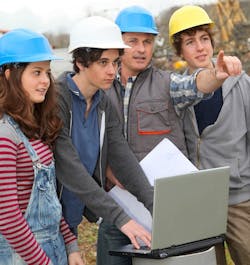Closing the skills gap in our industry will require generational give and take, and the engagement of each and every one of us
By: Sara Feuling
In thinking back on my college graduation ceremony 10 years ago, I remember looking around at my classmates as the University of Wisconsin-Milwaukee chancellor recognized the dozen or so female graduates in engineering as the highest number the school had ever seen.
I thought, “Way to go, ladies!” until realizing 100 of us were graduating that day and only one female could be found sitting in each row at the ceremony—that’s just one woman for every eight men. We had come a long way, the chancellor told us. Perhaps, but looking back I realize we still have so far to go. And for me, graduating and being one of a dozen female engineers out of a group of a hundred was not always the plan. But now, a decade later, I hope to help make it someone else’s in the future.
I come from a blue-collar background—a family with roots in farming, manufacturing, and the trades. My childhood was largely spent building things in the basement with my grandfather. As soon as my sisters and I were big enough to sit on a stool at his workbench, he handed us a small hammer, a bucket of nails, and a scrap piece of lumber.
My sisters and I made birdhouses and step stools with Grandpa, as well as furniture for our dolls with my father. But despite those experiences, I had no idea a career in construction was a viable option for me. I did not even know construction was an industry, and I certainly did not realize an opportunity existed for me, an opportunity to pursue a career with unlimited potential.
I always liked mathematics and science, as well as building things and drawing plans. But throughout my childhood, no one ever helped me make a connection between my interests and skills and careers in engineering or construction. It was not until college that, as an intern, I made the connection myself. A “happy accident,” as I call it.
My college career began with me pursuing architecture. While I believed it was the right fit, I found I missed math. The realization led me toward structural engineering and a belief that I was destined to be the next great design engineer. And, thanks to my background in architecture, I was poised to design and create innovative buildings and bridges.
My plans changed, however, following a summer spent working in construction as a field inspector. No longer would I build a career around designing buildings and bridges on paper in an office somewhere. Instead, I was determined to put on my steel-toe boots, get my hands a little dirty, and make my living bringing buildings and bridges to life.
That is how I ended up with a career in construction engineering, one which allowed me the uniquely valuable opportunity to play a significant role in the city of Milwaukee’s Zoo Interchange project, one of the largest road and bridge projects in Wisconsin’s history.
Many people desire a career which allows for a chance to make a positive difference in the world. Construction engineering affects hundreds of thousands of people, impacting their way of life on a daily basis. What better way to make a difference than to build and maintain infrastructure, and to connect people, goods, and services across the country? And in order to maximize the impact, everyone in the industry needs to be committed to helping the construction engineers of tomorrow make the connection between their budding skills and the career opportunities available to them.
WE SHOULD ALL BE ROLE MODELS
Since I almost missed the connection, I am now determined to ensure the next generation does not. I am active in my own community through STEM programs and other volunteer and mentoring opportunities, including mentor2.0 with Big Brothers & Big Sisters of Metro Milwaukee. Through a structured program, I mentor a high-school student who aspires to be an engineer. In addition to helping her navigate her way through available opportunities, I strive to be a role model for her; to show her that anyone—including women—can be successful in this industry.
We desperately need more people to be role models for the next generation of industry professionals. Formal education is important, whether it comes in the form of college or trade school. However, the industry needs to shift its focus beyond secondary education. Most of the skills necessary for professional success are learned on the job. Only so much knowledge can be gained about framing a building, driving a pile, or installing a pipe in a classroom. You need to learn hands-on.
Unfortunately, many on-the-job learned skills are often lost in the vast disconnect between generations in the industry. Much of the blame can be attributed to the negative connotations associated with the Millennial generation, a group of which I am a member. Millennials are described as lazy, entitled, and possessing an underdeveloped work ethic, but in point of fact there are members of the Baby Boomer generation, Generation X, and Generation Z that also possess those exact same character traits. Conversely, there are among all of these groups people who are steadfast, intelligent, and eager to learn and grow, and to make a positive contribution. It is time for us to move past the stereotypes and realize the advantages of employing people from all age groups.
It is also important to recognize that Millennials have a unique advantage in the workplace. This generation has been forced to adapt to new technology throughout our childhoods. Take music, for example. We saw cassettes, then CDs, then MP3s, then online streaming, all before most of us graduated high school. We are curious and inquisitive, we need a purpose and a definitive answer to the question “Why?” This is not a detriment; it’s a benefit. Progress and change come from curiosity, after all.
If older generations working within the industry are not willing or able to answer our questions, then young people will continue to push back and challenge authority—or worse, they will give up entirely. Neither outcome does much to dispel the existing stereotype, and the industry will fail to make any progress in closing the skills gap.
Older, experienced generations need to make an effort to connect with younger ones, and people who are new to the industry need to engage and learn from experienced, veteran professionals. It is a classic give-and-take, one which will only succeed if both generations are committed to working together.
Any successful effort starts small, with one person making an impact. Then another, and then another. The skills gap in the industry is no different. If one young person walks away from a career day presentation, a Future City competition, or a STEM event saying “I could do that—I could be like her,” then I have made a difference and helped change the narrative. More importantly, though, I have made the connection for him or her. I challenge you to do the same.
About The Author: Feuling is director of construction for the Association of Equipment Manufacturers.





